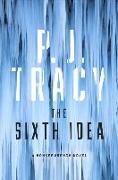Ulteriori informazioni
Zusatztext Praise for The Sixth Idea “A solid series that combines lighthearted characters and storytelling with serious mysteries.”— Booklist “Entertaining…The Monkeewrench gang need all their various skills to track other descendants! protect Lydia! uncover a clever conspiracy! and help end the carnage in this successful mix of detection and thriller.”— Publishers Weekly Informationen zum Autor P. J. Tracy is the pseudonym of the mother-daughter writing team of Patricia Lambrecht and Traci Lambrecht. They both live in Minnesota! outside Minneapolis. ***This excerpt is from an advance uncorrected copy proof*** Copyright © 2016 P. J. Tracy PROLOGUE -- 1957 Confine a dozen scientists and engineers to a seemingly endless desert of hard-packed sand with no recreational diversions and inevitably, they will design and build a golf course. “This is not just any golf course, Donald,” Arthur kept insisting. “This is Augusta, a near perfect replica of the first nine holes, minus the grass and the water hazards, of course.” “Both of which are somewhat critical components to any dandy golf course, wouldn’t you say?” “Stylistic details, Donald; a matter of preference. Tennis is played with equal enthusiasm on lawn and on clay. Think of this as golf’s version of a clay court. I think it’s ingenious, really.” “We could really use some caddies and a club house.” “I’ll give you that.” Arthur always dressed in the plaid knickers and cap of his hero, Bobby Jones, which looked especially ridiculous in the deserted New Mexico hinterlands. But that was the charming thing about Arthur – in his knickers and cap he was at Augusta, on the master’s course Bobby Jones had built, and he made you believe you were right there with him. Donald Buchanan and Arthur Friedman played the makeshift course almost every morning while the rest of the men slept. Most of the scientists preferred to work through the chill of the desert night and sleep through the most brutal heat of the day, but Donald and Arthur were paced to a different clock. “I have an idea,” Donald said as he lined up his drive. “Jesus Christ, the last time you said that, you and Teller damn near blew up half the world.” “That is a ridiculous exaggeration.” “It could still happen. Nice drive,” Arthur said as he watched a golf ball sail up into the dry air against a backdrop of blue sky and mountains. “So what’s this idea of yours?” “A bomb that doesn’t kill anybody.” “That defeats the purpose of a bomb, doesn’t it?” “Not necessarily. If you could invent something that would destroy infrastructure – power grids, delivery systems for weapons, communication, transportation – the enemy would be crippled with no cost of human life. The world would never again see the horrors of Hiroshima and Nagasaki.” “Without infrastructure, there are no resources, no order, no money, and nothing to buy with money even if you had cash in hand. Anarchy would fill the vacuum and people would die anyhow. Friends and neighbors would end up killing each other over a crust of bread or a vial of penicillin.” “Perhaps. But the death toll would be minimal in comparison to a multi-megaton atomic bomb.” “So you’re seeking a more moral weapon.” “I’m seeking a less morally repugnant one. Infrastructure can be rebuilt but humans cannot.” “And how do you propose to invent such a device?” “I don’t know yet. But the electromagnetic pulses the bombs generate intrigue me.” “You need a nuclear detonation to create an EMP substantial enough to be an effective weapon, which is exactly what you’re trying to avoid.” “Yes. But there has to be a way to generate EMP without a nuclear detonation. And if we could harness something like that, perhaps miniaturize it and selectiv...

